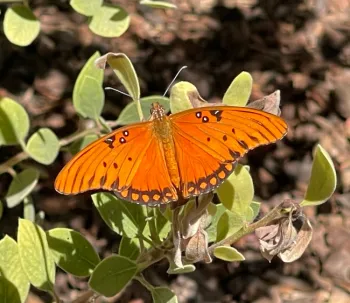

The Butterfly and Caterpillar
The Gulf fritillary is one of the showiest butterflies in California. With a wingspan that can reach four inches, the upper surface of the wings is bright orange-red. This vivid coloration is not just for show, but a warning to predators regarding its unpalatable taste. The underside is equally striking with large silvery-white spots on a muted orange-brown background, which provides camouflage when the wings are closed.

A tropical/subtropical butterfly, its range extends from southern and western United States all the way to central Argentina. Its spiny orange-and-black caterpillar feeds solely on Passionflower leaves (genus Passiflora). While not considered endangered, its population is affected by habitat loss, climate change, pesticides, and the availability of passion vines.
Metamorphosis
Like all butterflies, its life cycle is egg to caterpillar (larva) to pupa, to adult, which takes about 5-6 weeks for the Gulf fritillary:
Eggs: The female butterfly generally lays a single egg yellowish in color on the surface of passion vine leaf. She may lay several single eggs on several leaves. The egg stage duration is 4 to 8 days.

Caterpillar: Once the egg hatches, the caterpillar will voraciously feed on the passion vine leaves for 2-3 weeks. It will grow rapidly during this period, molting its exoskeleton; the period between each molt is called an “instar.” Like the colorful adult butterfly, its distinctive orange-black coloring and “spines” serve as a warning to potential predators.
Pupa: After reaching sufficient size, the pupal stage will begin. The caterpillar will first go into an upside-down “J” position by attaching itself with a plug of silk on a branch or other nearby solid surface (such as a fence). Within a few hours it will form a greenish-brown chrysalis, which will dry out by the next day to look somewhat like a brown, withered leaf. The pupal stage is a time of significant transformation and lasts about 5-10 days.

Adult: When the adult butterfly is getting ready to emerge, the chrysalis will begin to change, becoming clearer – you can observe the black wings inside. The chrysalis will also begin to split. After emerging, the adult will hang onto the now-empty chrysalis, pumping a liquid into its wings to expand them and drying, before it can fly.
During the next 2 to 4 weeks, it will feed on nectar (thus pollinating flowers) and mate, producing the next generation. Male and female butterflies are quite similar, with the female being slightly larger and males having more pronounced coloring.
Gulf fritillaries have a graceful, agile flight, with rapid wingbeats and gliding. They are sometimes mistaken for monarch butterflies, but are generally smaller and fly more quickly.

Unlike some butterflies, it generally does not engage in long migrations, though it may move further north or south in a region according to changes in the seasons and food availability.
Adults are attracted to flowers that include lantana, aster, coreopsis, and black-eyed Susan (Rudbeckia hirta).
Passion Vine


Train passion vines on trellises or walls. Due to its vigorous growth, it can become overgrown and tangled, so untangling and thinning may be required. Varieties that can be grown in our area include Blue Crown (P. caerulea), Wild Passion Vine (P. incarnata), P. ‘Incense,' and P. ‘Lavender Lady.' Avoid using pesticides which can harm caterpillars and adult butterflies.

“My” Caterpillars
It amazes me how a Gulf fritillary female butterfly found my small passion vine so soon after it was planted, which is still too young to begin producing their showy flowers (hopefully next spring!). I've enjoyed checking “my” caterpillars daily, watching them devour leaves on the vine (which will recover!). I went out multiple times daily when I notice a caterpillar in the “J” position and watch them develop their chrysalis.
Some caterpillars and chrysalis have mysteriously disappeared during the night, but I continue to see adult butterflies flitting about flowers in my garden, mating, see more eggs on leaves and young caterpillars. I look forward to continuing to observe the miracle of the metamorphosis stages from eggs to new beautiful butterflies emerging from their chrysalis and flying in our garden through the remainder of summer.

Denise Godbout-Avant has been a UC Cooperative Extension Master Gardener in Stanislaus County since 2020.
For More Information on Gulf Fritillaries and Passion Vines
BugSquad: That's One Beautiful Butterfly: https://ucanr.edu/blogs/blogcore/postdetail.cfm?postnum=10835
Bug Squad: Gulf Fritillary – A Glorious Butterfly: https://ucanr.edu/blogs/blogcore/postdetail.cfm?postnum=38566&postnum=38566
Art Shapiro's Butterfly Site: https://butterfly.ucdavis.edu/news/gulf-fritillary-colonizes-sacramento-and-davis
Sunset Western Garden Book

